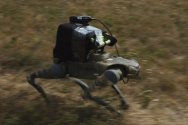Ones with electric motors will be quiet.Seriously, if you use either of these, carrying them is difficult on its own, not to mention the noise they make when carrying them. A robot dog avoids both of these problems. What's more, it can basically move over all terrain for a much wider range of applications, and I'm only talking about one particular case here.
Doesn't even have to be a whole golf cart, could be as simple as a skateboard.
Long story short, the dog is a complex device, many multiple servo motors for the articulation, control chips, etc.. If your example is just a suicide bomb truck (a la 2000's-style terrorism), then those are a waste of thousands of dollars. Also the increased complexity means more possible points of failure.
The Ukraine conflict is basically on the cutting edge of novel drone applications. We actually have seen them experiment with the Unitree, but suicide attacks are uncommon.
Aside: Hilariously, the article mentions that some other sources state that the dogs are 'British-built' which I have seen referenced as well, but it is just a Unitree, so I guess they are stealing Chinese IP, lol.


